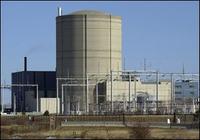-
Innovative ultrasonic nozzle changes the way water cleans
Scientists have developed a revolutionary ultrasonic attachment for taps, which massively enhances the ability of water to clean; currently, industry uses excessive water, power, and additives for cleaning
-
-
Hairline cracks discovered in Ohio nuclear plant

The discovery of several hairline cracks at a nuclear power plant in Ohio has watchdog groups questioning its structural integrity; on Monday a team of inspectors found several hairline cracks including one thirty-feet long at the Davis-Besse nuclear power plant, located outside of Toledo
-
-
Protecting infrastructure from natural hazards
Accurate mapping data plays an important role in improving the resilience of the U.K.’s critical infrastructure to disruption from natural hazards
-
-
Chemical industry hit by “Nitro” cyberattacks
In a string of cyberattacks, hackers have stolen critical formulas and plans from major chemical companies; the latest attacks, dubbed “Nitro,” were uncovered by Symanetec, which reported the hackers aims were corporate espionage rather than a terrorist attempt to procure chemicals
-
-
Eight months later, Fukushima reactor could still be active
Troubles continue at the beleaguered Fukushima Daichii nuclear power plant in Japan with officials detecting radioactive xenon gas, a byproduct of nuclear fission, from reactor two nearly eight months after the dangerous meltdowns
-
-
New source of energy: urine
Urine is the most abundant waste on Earth; American chemists have combined refueling one’s car and relieving one’s bladder by creating a new catalyst that can extract hydrogen from urine
-
-
Hybrid power plants: cost effective way to go green
Hybrid cars, powered by a mixture of gas and electricity, have become a practical way to “go green” on the roads; now researchers at Tel Aviv University are using the hybrid approach to power plants as well
-
-
Big asteroid to fly uncomfortably close to Earth
A hefty asteroid — dubbed asteroid 2005 YU55 — will zoom uncomfortable close to Earth on Tuesday, 8 November; the asteroid is classified as a potentially hazardous object, but it poses no threat of an Earth collision — for at least the next 100 years; scientists say the asteroid is a reminder that our planet is just a sitting duck in a cosmic shooting gallery
-
-
DHS warns Anonymous may target critical infrastructure
DHS is warning critical infrastructure operators that the international hacking group known as Anonymous has threatened to attack industrial control systems, the software that governs automated processes for nearly every major utility or production facility including factories, power stations, chemical plants, and pharmacies
-
-
Nuclear power shortages forces Japan to reduce consumption
As winter approaches, residents of Japan are being asked to cut power consumption by 10 percent as many of the country’s nuclear reactors have remained offline since the disaster at the Fukushima Daiichi atomic energy plant
-
-
Army engineers need $1 billion to repair damaged levees
The U.S. Army Corps of Engineers is urgently requesting $1 billion to repair flood control systems along the Mississippi and Missouri river basins following damage from record floods this spring; the historic flooding forced the corps to blow up portions of the levee to relieve pressure, flooding thousands of acres of farmland to protect cities along the rivers
-
-
New technology for safe storage of radioactive waste
Researchers have developed new technology capable of removing radioactive material from contaminated water and aiding clean-up efforts following nuclear disasters
-
-
Sector Report for Monday, 31 October 2011: Infrastructure protection
This report contains the following stories.
Plus 1 additional story.
-
-
More than 18,000 bridges in metro areas structurally deficient
A recently released report found that more than 18,000 U.S. bridges in the busiest cities are “structurally deficient”; each day 75 percent of all traffic crosses one of these deficient bridges and in cities like Los Angeles, an average of 396 drivers cross a deficient bridge every second
-
-
Electrical grid targeted by hackers
The co-chair of the Congressional Cybersecurity Caucus warns that U.S. electrical grids are becoming increasingly attractive targets for hackers in a potential cyberwar
-
- All
- Regional
- Water
- Biometrics
- Borders/Immig
- Business
- Cybersecurity
- Detection
- Disasters
- Government
- Infrastructure
- International
- Public health
- Public Safety
- Communication interoperabillity
- Emergency services
- Emergency medical services
- Fire
- First response
- IEDs
- Law Enforcement
- Law Enforcement Technology
- Military technology
- Nonlethal weapons
- Nuclear weapons
- Personal protection equipment
- Police
- Notification /alert systems
- Situational awareness
- Weapons systems
- Sci-Tech
- Sector Reports
- Surveillance
- Transportation
Advertising & Marketing: advertise@newswirepubs.com
Editorial: editor@newswirepubs.com
General: info@newswirepubs.com
2010-2011 © News Wire Publications, LLC News Wire Publications, LLC
220 Old Country Road | Suite 200 | Mineola | New York | 11501
Permissions and Policies
Editorial: editor@newswirepubs.com
General: info@newswirepubs.com
2010-2011 © News Wire Publications, LLC News Wire Publications, LLC
220 Old Country Road | Suite 200 | Mineola | New York | 11501
Permissions and Policies
